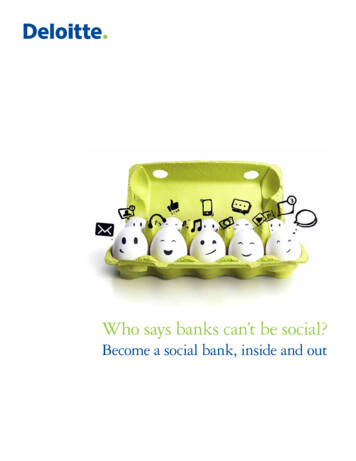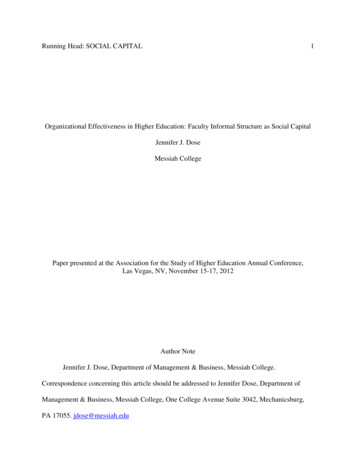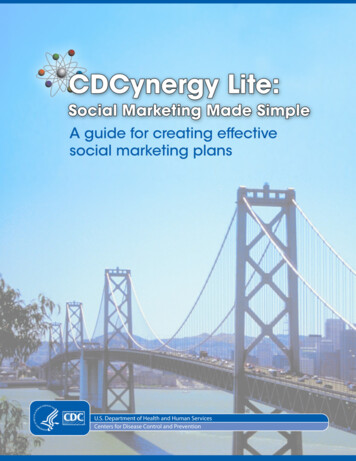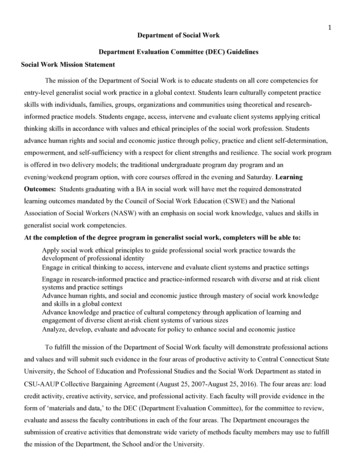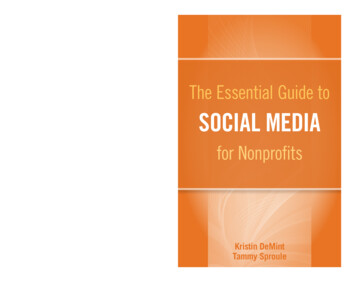
Transcription
In today’s culture, to gain support for your nonprofit, being onsocial media is an absolute must. It’s a simple, yet effective toolto get your mission, message, and cause out there — for little tono cost. However, with so many social media channels availableand limited time to invest in your outreach efforts, you need towork smarter with your social media, not harder. But choosing theright channel and the right tactics can be tricky.The Essential Guide to Social Media for Nonprofits provides youa primer for making effective decisions for your strategy whetheryou’re new to the social media space or looking to improve yourexisting presence. In this book, you discover how to: CHOOSE THE RIGHT CHANNELGAIN FOLLOWERS AND FRIENDSLISTEN TO YOUR AUDIENCE AND LEARN ABOUT THEMBE HEARD WHERE YOU WANT TO BE HEARDEasy-to-understand language and practical tips make The EssentialGuide to Social Media for Nonprofits a quick way to get that muchcloser to your social media goals and your organization’s mission.Cover art Roman Okopny/iStockphotoISBN: 978-1-118-93344-2Not for resaleThe Essential Guide toSocial Mediafor NonprofitsKristin DeMintTammy Sproule
These materials are 2014 John Wiley & Sons, Inc. Any dissemination, distribution, or unauthorized use is strictly prohibited.
The Essential Guideto Social Mediafor NonprofitsBy Kristin DeMint and Tammy SprouleThese materials are 2014 John Wiley & Sons, Inc. Any dissemination, distribution, or unauthorized use is strictly prohibited.
Publisher’sAcknowledgmentsSome of the people whohelped bring this book tomarket include the following:Project Editor:Carrie A. JohnsonEditorial Manager:Rev MengleBusiness DevelopmentRepresentative:Sue BlessingCustom Publishing ProjectSpecialist:Michael SullivanProject Coordinator:Melissa CossellThe Essential Guide to SocialMedia for NonprofitsPublished byJohn Wiley & Sons, Inc.111 River StreetHoboken, NJ 07030-5774Copyright 2014 by John Wiley & Sons, Inc.No part of this publication may be reproduced,stored in a retrieval system or transmitted in anyform or by any means, electronic, mechanical,photocopying, recording, scanning or otherwise,except as permitted under Sections 107 or 108 ofthe 1976 United States Copyright Act, withoutthe prior written permission of the Publisher.Requests to the Publisher for permission shouldbe addressed to the Permissions Department, JohnWiley & Sons, Inc., 111 River Street, Hoboken, NJ07030, (201) 748-6011, fax (201) 748-6008, or onlineat http://www.wiley.com/go/permissions.Trademarks: Wiley, the Wiley Publishing logo, ForDummies, the Dummies Man logo, A Reference forthe Rest of Us!, The Dummies Way, Dummies Daily, The Fun and Easy Way, Dummies.com, and related trade dress are trademarks or registered trademarks of John Wiley &Sons, Inc. and/or its affiliates in the United States and other countries, and may notbe used without written permission. Salsa Labs and the Salsa Labs logo are registeredtrademarks of Salsa Labs. All other trademarks are the property of their respectiveowners. Wiley Publishing, Inc., is not associated with any product or vendor mentionedin this book.LIMIT OF LIABILITY/DISCLAIMER OF WARRANTY: THE PUBLISHER AND THE AUTHORMAKE NO REPRESENTATIONS OR WARRANTIES WITH RESPECT TO THE ACCURACY ORCOMPLETENESS OF THE CONTENTS OF THIS WORK AND SPECIFICALLY DISCLAIM ALLWARRANTIES, INCLUDING WITHOUT LIMITATION WARRANTIES OF FITNESS FOR A PARTI CULAR PURPOSE. NO WARRANTY MAY BE CREATED OR EXTENDED BY SALES OR PROMO TIONAL MATERIALS. THE ADVICE AND STRATEGIES CONTAINED HEREIN MAY NOT BESUITABLE FOR EVERY SITUATION. THIS WORK IS SOLD WITH THE UNDERSTANDING THATTHE PUBLISHER IS NOT ENGAGED IN RENDERING LEGAL, ACCOUNTING, OR OTHERPROFESSIONAL SERVICES. IF PROFESSIONAL ASSISTANCE IS REQUIRED, THE SERVICES OFA COMPETENT PROFESSIONAL PERSON SHOULD BE SOUGHT. NEITHER THE PUBLISHERNOR THE AUTHOR SHALL BE LIABLE FOR DAMAGES ARISING HEREFROM. THE FACT THATAN ORGANIZATION OR WEBSITE IS REFERRED TO IN THIS WORK AS A CITATION AND/OR APOTENTIAL SOURCE OF FURTHER INFORMATION DOES NOT MEAN THAT THE AUTHOR ORTHE PUBLISHER ENDORSES THE INFORMATION THE ORGANIZATION OR WEBSITE MAYPROVIDE OR RECOMMENDATIONS IT MAY MAKE. FURTHER, READERS SHOULD BE AWARETHAT INTERNET WEBSITES LISTED IN THIS WORK MAY HAVE CHANGED OR DISAPPEAREDBETWEEN WHEN THIS WORK WAS WRITTEN AND WHEN IT IS READ.ISBN: 978-1-118-93344-2 (pbk)ISBN: 978-1-118-93723-5 (ebk)Manufactured in the United States of America10 9 8 7 6 5 4 3 2 1These materials are 2014 John Wiley & Sons, Inc. Any dissemination, distribution, or unauthorized use is strictly prohibited.
1USocial Media Your Nonprofit A Good Match?ltimately, your goal as a nonprofit is to garnersupport — advocates, financial supporters, andso on. In order to get that support, you have toget noticed. Sure, email and direct mail are useful toolsto reach the people you already know, but how do youreach those that you don’t? Two words: social media.You live in an era where information recipients are all potential publishers; if you’re receiving email, odds are you have the power to forward it to tens, hundreds, or thousands of others with just a few clicks.The typical user is online every day, if not constantly tethered. What’smore, people believe their family and friends far more than they do anorganization, nonprofit or not. Getting your message to spread widelyand quickly happens when people get information from more trustedsources, and that requires social media.Keep in mind, too, that if you have a multi-channel (events, direct mail,social media, and integrated email) marketing strategy — meaning onlineand offline — donors are four times more valuable than a single-channel(modifies donor) donor.These materials are 2014 John Wiley & Sons, Inc. Any dissemination, distribution, or unauthorized use is strictly prohibited.
chapter1 Social Media Your Nonprofit A Good Match?2So what makes viral messages spread, well, like a virus? Right time,right message, right place. There are steps you can take, though, tovastly improve your odds, and using social media is a critical part ofyour action plan. This chapter explains why.The Potentials of Social MediaAccording to the folks at M R Strategic Services and the NonprofitTechnology Enterprise Network (NTEN), 2012 data on email, fundraising, advocacy, social media, and mobile from 55 of the nation’s leadingnonprofits suggest the following trends: Online revenue was up 21 percent. Monthly giving was positivelybooming, up 43 percent. Social media audience sizes skyrocketed, with nonprofits’ Twitterfollowers increasing by 264 percent. Metrics like click-through and response rate went down for bothfundraising and advocacy emails.What do these numbers suggest? If you aren’t active in social mediachannels, your nonprofit is missing a huge potential for revenue andother types of support. Why? Because everyone is online! From millennials to GenX to Baby Boomers, the vast majority of the world’s population is connected online to one another, to their favorite brands, and tothe causes they care about most.Also known as Generation Y, the millennial generation encompasses anyoneborn from the late 1970s to the early 2000s. That’s an estimated 80 millionpeople! The sheer number of people alone makes them important to connect with, but it gets better. They are the first generation to have grownup with the Internet and are very tech savvy, which is great, if you knowwhere to reach them.It’s important to connect with this group now because they’re futurepotential activists. They’re responsive and have great expectations ofthose organizations with which they interact, including wanting impeccable credibility. So how do you do it?Traditional media doesn’t always work with millennials. To connectwith them, you have to find other ways to engage them. One great placeto start is social media — estimates say that 75 to 90 percent of thisgeneration has one or more social media profile(s). (Older supportersare also adopting social media at a rapid pace — 78 percent of GenX,60 percent of Boomers, and even 43 percent of Americans over 65 use atleast one site.)These materials are 2014 John Wiley & Sons, Inc. Any dissemination, distribution, or unauthorized use is strictly prohibited.
3ence. They know what their friends are up to and what they care about,and they’re heavily influenced by each other. Offer content that’s worthsharing and they will do it, spreading your message for you. Use tacticslike storytelling, humor, and urgency to grab their attention. (For moreon social media best practices, flip ahead to Chapter 3.)The Big Question: Will YourNonprofit Benefit?chapter1The answer to the question of whether your nonprofit, no matter yoursector, will benefit from social media efforts is yes (if, of course, youleverage your efforts well — which Salsa and this book help you do).Why? People are on email overload only reading the ones they reallywant with the help of spam filters and Google’s new tabs; they prefersocial media where they can control the pace as well as what is important to them. Nonprofits and political organizations today need to beprepared for the social conversation by taking the first steps: listeningand going where the conversation is happening.Social Media Your Nonprofit A Good Match? Another way to reach online supporters is through peer-to-peer influ-You may not think you have time for social media, but it’s going onaround you. Users are now in control of a significant part of your message, not just as users, but as influencers. Individuals are influenced byfriends, friends’ friends, and friends’ friends’ friends. Take advantage ofthe discussion, find out who your online supporters are, personalizeyour message, and make sure they’re involved with your cause.By integrating social media with your email lists, you can Identify the influencers: Not every supporter on your list is equal.Some have greater reach than others, and it is important thatyou identify and segment those supporters. After you determinewho’s interested in your cause, see who they follow and whatmessages resonate with them most. You can then target your keyinfluencers who will push your message to their lists, reaching afar wider network. Increase fundraising: Embedding social media into your emailsopens multiple channels for communications, increasingdonations. And with a simple click of the mouse, supporters cancomplete donations in seconds, directly through their email. Noforms to fill out, no credit card information to input, just clickand give.These materials are 2014 John Wiley & Sons, Inc. Any dissemination, distribution, or unauthorized use is strictly prohibited.
chapter1 Social Media Your Nonprofit A Good Match?4 Maximize your message’s life span: If you ask your followers toshare your message on their Facebook pages and to re-Tweet totheir groups, you can maximize the shelf life of your message. Anddon’t just ask once — you can add your website, email, and socialmedia to all your materials.The Channels: Where ShouldYou Invest, and How Much?With hundreds of social media sites out there, how do you choosewhich ones to use for your organization? You can’t possibly be on everynetwork, so don’t even try. Pick the two or three that make the mostsense and approach them with gusto: Do your research to figure out on which social media channelsyour supporters spend the most time. Start with Facebook andTwitter, but you may find your specific audience prefers somethingelse, like LinkedIn, Google , Pinterest, or Instagram. Join the networksthat your audience is using or that have an audience you have thepotential to connect with. Meet them where they are; don’t just jointo join. And remember, each network has its own demographics. Consider sites with a strategic advantage. Being on Google canhelp your search rankings on Google. You can create content in Vinethat can be shared in other places, like on its sister site, Twitter. Before you hop on a new site, think about your level of performanceand engagement on your current sites. Evaluate whether you havethe time and content to truly succeed on each site. Remember that it’s okay to say goodbye. It’s actually better toleave a social media platform altogether than have a page that’sneglected. When you join a new site, be sure to approach it with a strategicplan. Consider the audience on that site, the content you’ll be ableto share with them, the times they are on the site most, your endgoals for your presence, and so on.Many tools are available for social append, which is matching up yoursocial media supporters to your email list. You can read about some ofthese tools at www.salsalabs.com/social-append.These materials are 2014 John Wiley & Sons, Inc. Any dissemination, distribution, or unauthorized use is strictly prohibited.
2ROptimizingYour Presencein Social MediaChannelsarely in history have movements been trulyspontaneous — nearly always, it’s been theoften-unseen strategic work of hundreds oreven thousands of individuals. Trying, failing, andtrying again, until suddenly it seems inevitable.Nor are social networks new, of course — the only difference is thatsome of these networks are now made visible online. Strategies hashedout in the homes of workers during labor movements, black churchesin the U.S. Civil Rights Movement, gay bars in LGBT movements, andcollege campuses in student movements have plenty to say to today.Friendships, communities, and cultural ties are the birthplaces of socialjustice. People rely on their connections with others to work for socialchange — but relationships online can mirror social injustice aroundrace, gender, class, and more. The existence of online social networksmakes your job easier in some ways, but it doesn’t replace the need forstrategizing how you’ll use them.Building a Long-Term StrategyWhile working online, it’s easy to get sidetracked into focusing on thetools — the shiny object syndrome. You think, “We need to be on thisThese materials are 2014 John Wiley & Sons, Inc. Any dissemination, distribution, or unauthorized use is strictly prohibited.
social network, using this app, or spreading our appeals using this tool.”Organizers are always using new tools creatively, but looking to pastcampaigns shows how strategy has always trumped technology in successful movements. Take the fax machine, for example. In the 1990s, itwas used by The International Campaign to Ban Landmines to knit together acoalition of disparate non-governmental organizations Turkish pro-democracy organizers to spread a coordinatednationwide nonviolent demonstration Activists in New York City who jammed the fax machines of cityofficials responsible for bulldozing community gardensOne tool, three strategies. In this light, “Twitter activism” or “Facebookfundraising” won’t be an effective plan, because it substitutes the tool forthe strategy. In addition, starting with your favorite tool will limit yourcampaign strategy to tactics that work with that tool — it constrains yourvision and can result in diminished effectiveness. Before you sit down atthe computer, you need a good social media strategy — one that’s organized around the elements in this section.chapter2 Optimizing Your Presence in Social Media Channels6Point toward long-term changeBe sure your online organizing or digital activism components are pointing toward a larger picture. Every action should aim at a long-term goalin addition to a short-term objective, and that “line of sight” should beclear to your supporters as well. No viral marketing campaign is going toconvince people to sign your petition or make a donation if the objectiveisn’t crystal clear.In the U.S. Civil Rights Movement, there were many individual campaigns — the Montgomery bus boycott, the Nashville lunch counter sit-ins, the Freedom Rides, the voter registration drives, the March onWashington and more. In each case, organizers and strategists likeMartin Luther King, Jr., Ella Baker, and Bayard Rustin publicly connectedthe individual campaigns to the larger movement. The approach wasgrounded in community organizing, what Baker called “spadework” — preparing your garden to flourish in the next season.Instead of building standalone, siloed campaigns, try connecting eachaction to the larger vision — publicly — and integrate community organizing to bring supporters closer to each other and build a deeper connection to the movement. Remember that new supporters won’t beready for big actions right off the bat, and creating personal connections with existing supporters can help their learning and growth intoyour next dedicated supporter.These materials are 2014 John Wiley & Sons, Inc. Any dissemination, distribution, or unauthorized use is strictly prohibited.
7You’re not competing with other organizations for the same supporters —donors or activists; you’re building bridges to a better future with manyhands. Rising movements benefit organizations — people who areinspired to act, speak, or donate for one group are more likely to do sofor a related one.The project Upwell.us researches online conversations about marineconservation in order to equip organizations across that movement withinformation to develop more strategic campaigns. Instead of groupscompeting with one another for funding and supporters, Upwell’s motto“the ocean is our client” is helping frame ocean conservancy as a movement with many players, in which a rising tide of support really doesraise all boats. For instance, their analysis of “shark week” revealed thatdespite a media focus on “shark terror,” much of the online conversationwas about “sharks being awesome.” With that information, marine conservation groups knew investing in social media outreach during theweek would pay off — and it did, dramatically.chapter2Use social media to become a source of knowledge for your cause. Becomea content curator. Don’t endlessly repeat your own talking points or pretend you’re the only group out there that cares about the issue. Shareinformation from groups doing similar work in different places — yoursupporters will be both better informed and more inspired. Think aboutbuilding the movement instead of just your list.Optimizing Your Presence in Social Media Channels Embrace solidarityEngage, don’t broadcastIf you connect everyone to yourself, you’ve created a hub and spoke.You’re in control, but if anything goes awry or some spokes get out ofwhack, a crash is going to be imminent. Instead, use online tools to buildwebs of conversation — facilitate connections among your supporters,not just between them and you. A community of social change will befar stronger in your movement than a bunch of names on a mailing list.Remember, you have supporters who are passionate about your sharedconcerns and are waiting to speak in their own voice. Give them thetools to speak — craft a strategy, set up the action opportunities, andamplify emerging leaders. For instance, the organization charity:waterenables people to create their own fundraising campaigns, and then itfeatures the most creative ones. Goodwill scours the Internet for blogs,posts, and Tweets about their work and their thrift stores and thenhighlights them on Facebook. Many national nonprofits encouragelocal members to submit photos or videos of their work, which theythen spread on social media — featuring their most active supporters.These materials are 2014 John Wiley & Sons, Inc. Any dissemination, distribution, or unauthorized use is strictly prohibited.
chapter2 Optimizing Your Presence in Social Media Channels8Above all, don’t speak for your network. It’s not “billboard media”; it’ssocial media — cultivate these social networks of change. Stories appealto our heart, not just our brain, and shareable content with a personalstory from a supporter is much more likely to go viral than another “takeaction now” headline.Listen, measure, and be agileIf you haven’t reached your objectives — or it becomes clear that a winis going to be further off than you expected — it’s important to recognize smaller wins too: If the number of supporters has increased, ornew leadership has developed, or stronger networks have formed, thenyou’re in a better place to start a subsequent campaign, even if youroriginal goals weren’t met.For instance, MomsRising regularly solicits stories from its audience tosee what issues matter, and then frames its work around it. MomsRisingcarefully measures its impact and adjusts campaigns accordingly. Forinstance, when the group said, “please share your childcare story,” therewasn’t much response. So it changed the prompt to “What is your experience finding affordable childcare?” and got much more engagement.When supporters send in compelling stories, MomsRising works withthem to hone the story and prepare it for sharing more publicly — withlegislators, the media, and other potential supporters. MomsRising’s network becomes its strength, not just as names on a petition or volunteersign-up form but in pushing the movement forward.Creating Your Personaand ProfilesAs nonprofit organizers and dogooders, you often don’t think first abouthow you look — vanity isn’t usually a word used to describe you. But your“curb appeal” often influences whether people will give you the time ofday. As you enter social media channels, think in particular about yourprofile, page, group name, and your voice.What’s in a name?If you’re like most folks, odds are you immediately know what youshould name your profile or page in social media. After all, it’s obviousthat you should just use the name of the organization itself, right?Obvious, yes. But effective? Maybe not. Yes, you’ll want to have a pageThese materials are 2014 John Wiley & Sons, Inc. Any dissemination, distribution, or unauthorized use is strictly prohibited.
9Take, for example, Left Action, a progressive activist network with over1 million activists. The Facebook page for the organization has nearly600,000 fans, which ranks it among the top political pages. But LeftAction didn’t start with Left Action — not with a Facebook page by thatname, that is. It started as a series of Facebook pages entitled thingslike “Not Having George Bush as President,” “Telling Dick Cheney toShut the Hell Up,” “Telling Sarah Palin She’s Full of Crap,” and so on.When John Hlinko was ready to launch Left Action, both the site andthe Facebook page, he was able to use these pages to jump start theprocess far more quickly than if he’d started from scratch with LeftAction itself. Fans who’d already been receiving and responding to postsfrom those pages for months were much more predisposed to give achance to the new, like-minded page than if they’d been pitched it cold.So what makes a page effective? Consider the following tips: Name it something you know supporters already agree with.Make it easy for them to “like” you — they should be able to tell ata glance just what you’re advocating.Left Action examples, for example, are all clearly designed toappeal to left-activist types.2 Think of what will stand out in a feed. When someone becomes achapter Make sure it’s in sync with your organization’s larger goal. TheOptimizing Your Presence in Social Media Channels with your organization name, but you won’t want to stop there — orperhaps even start there.fan of a page or adds a new friend, some percentage of their friendswill see that activity noted in their feeds. Feeds are crowded things,of course, so if you can make your name stand out from the dinby using humor, a play on words, and so on, then you’re far morelikely to have those friends click it to learn more, and become fansor friends themselves. “John Hlinko likes Left Action” in a feed mayprovoke some clicks, but “John Hlinko likes Telling Sarah Palin She’sFull of Crap” will get a heck of a lot more. Check out Facebook’s rules to make sure you don’t run afoul ofthem. For example, Facebook has (or at least had) a habit of disapproving generic pages not representing a brand. Putting “byLeftAction.com” in parentheses after the name enabled thehumorous pages to go through, avoiding FB’s wrath but still havinga minimal impact on the power of the title.Give it a shot, get creative, and don’t just stick with the obvious approach.You may not get a million fans, but with a little creativity and a little testing,your odds of doing well are a heck of a lot higher.These materials are 2014 John Wiley & Sons, Inc. Any dissemination, distribution, or unauthorized use is strictly prohibited.
chapter2 Optimizing Your Presence in Social Media Channels10Images tell allTaking a few extra minutes to design your accounts with imagery thatties into your campaign will make your organization look more professional on social media and can tell your story in an instant, compellingsupporters to stay. Each channel is a unique community with its ownculture, codes, and rules, and you need to understand those communities to be a part of them. Generally, your profile or page will have thefollowing images: Profile picture: This photo is your identity. It’s the little picturethat appears with your tweets or with your status updates in afeed. Because it’s so small, it’s best to go with something clearand easy to see, like your brand’s logo or a picture of your face.If you have a large logo, is there a mark (a portion of your logo)that’s easily identifiable to use in its place? Think of it this way:If your nonprofit was a person, a faraway shot of you in front ofa mountain is unrecognizable; a close-up on your face lets themknow quickly they’re on the right page. Banner image or cover photo: This is the backdrop image behindyour profile picture in both Twitter, Facebook, YouTube, and Google .An iconic photo of your organization’s identity (or your own) or animage that helps supporters recognize your brand or colors worksbest here. Examples include a photo of a group of volunteers doingwork for your organization, pictures of beneficiaries of your work(like dogs and cats for the Humane Society), or an iconic image ofwhat you’re fighting for or where you’re from. Background image: This image is unique to sites like Twitter andis the image design behind all your posts and profile information.A great background photo is usually one image (not a tiled versionof a small image) and has your brand imagery/logo on the left sideof the feed so it can be seen clearly.A distinct voice is easily heardIt’s in your favor to develop a distinct voice for your organization (or foryourself) so your posts and tweets can shine above the masses. This canbe especially difficult if you’re an organization, which is usually a collection of distinct voices. So don’t be afraid to experiment with differentvoices and see what sticks. Don’t be afraid to fail — social media is allabout iterations. Try something, look at how people react, adjust, andtry again. Then, do your best to get everyone in your organization thatposts to social media to match that voice as best they can.These materials are 2014 John Wiley & Sons, Inc. Any dissemination, distribution, or unauthorized use is strictly prohibited.
11 Who are your potential supporters? Who would they relate to when someone talks to them? How do they want to be talked to? Casually? Formally? How will the message be forwarded? Who do you want to forward it?Establish a persona, an ideal message carrier. Build a personality, withlikes and dislikes; why would this person care about you and your cause?What would [insert personality name] do?Gaining Followers2After you’ve made the decision to join social media networks and havecreated your page or profile, the first big task is building your supporterbase. How you do that varies according to the channel.chapterBigger communities don’t just let you reach more people — they let yourcurrent supporters see they’re part of something much bigger. And thatkind of realization can be key to encouraging folks to check out whatyou’re up to and share your stuff. Nobody wants to be all alone “liking”and “sharing” your stuff, you know?Optimizing Your Presence in Social Media Channels When thinking about voice, ask yourself these questions:On FacebookThere’s no reason your campaign should have a small Facebook page — orif you already have a few hundred or a few thousand fans, why you can’tgrow significantly. You can grow your Facebook presence in different ways: Ask your friends to “like” the page. These days, anyone can accessthe feature to invite friends to “like” a page. So, why not encourageall your staff and core volunteers to invite all their friends? Hostan “invite your friends” pizza party! If ten of your core staff andvolunteers invite all their friends, and on average you have 300friends each, you will have invited 3,000 friends in one fell swoop.If just 10 percent say yes, that could be 300 new fans for your page! Include a “like us on Facebook” button on your website. A multi-channel platform needs to be well integrated, with all channelsultimately directing supporters back to your website. The website,though, should also point readers to your social networks, wherethey can interact with the community you’ve created.These materials are 2014 John Wiley & Sons, Inc. Any dissemination, distribution, or unauthorized use is strictly prohibited.
chapter2 Optimizing Your Presence in Social Media Channels12 Use Facebook ads or boost a post to target potential supportersto “like” your page. Use these pay-for options to extend yourreach to beyond just your core group of supporters. You can gainmore “likes” or perhaps even eventual donors with these options.Let Facebook help you. And, you set the budget. Facebook has aminimum, but it isn’t budget-breaking. Post compelling content that people want to share. The newsfeedis the heart of Facebook, so focus on creating engaging contentthat your support
Dummies, the Dummies Man logo, A Reference for the Rest of Us!, The Dummies Way, Dummies Daily, The Fun and Easy Way, Dummies. . social media, and integrated email) marketing strategy — meaning online and offline — donors are four times mo








